 |
|
 |
|
|
If your browser labels this site "Not Secure," click here.
|
|
2018
October
31
|
And one more...
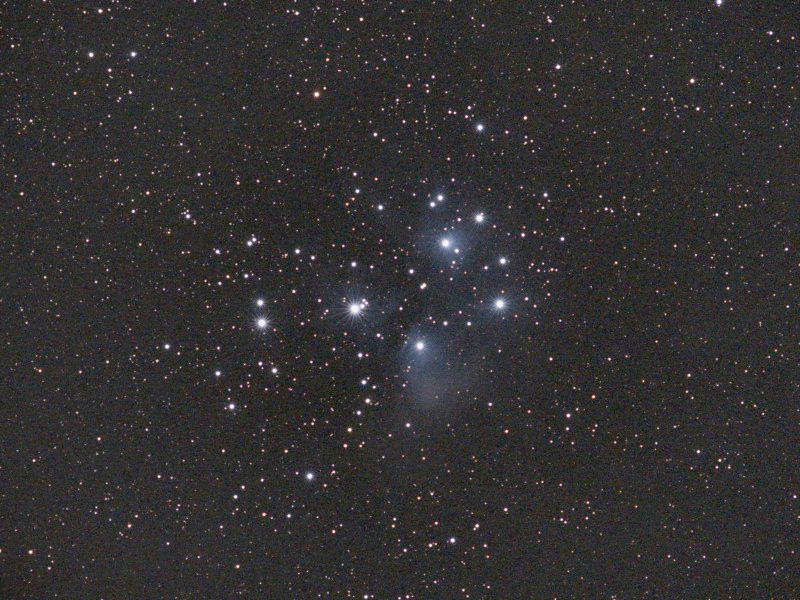
One more picture from the evening of the 29th. The Pleiades star cluster
(with some interstellar dust), a stack of
just two 2-minute exposures because the moon was rising. This is another case of
"teaching a new dog old tricks" because I'm using new (to me) equipment to take a picture
that I've taken many times before. (The Pleiades are one of the few things that are
easy to photograph well on film, so I've been photographing them a long time.)
Still, it was good enough to put in the Daily Notebook.
Permanent link to this entry


|
2018
October
30
|
A fine crop of astrophotos
Last night (October 29), we had unusually clear air, and at my home in Athens, Georgia,
I was able to do quite a bit of deep-sky photography (for a change!).
My goal was to find out the best way to use my battle-weary Nikon 180/2.8 ED AI lens,
which has perceptible decentering and chromatic aberration at f/2.8 (probably not detectable
with film, only digital sensors).
Results: (1) It works fine at f/4, even with an extended-red-sensitivity camera;
(2) with the AVX mount, I can expose for 2 minutes without guiding corrections, or
3 minutes if I want to throw out a few frames.
All of the following pictures were taken with that lens at f/4 and a Canon 60Da camera
(with Nikon lens adapter), and each is a stack of ten 2-minute exposures.
Let's start with the North America Nebula...
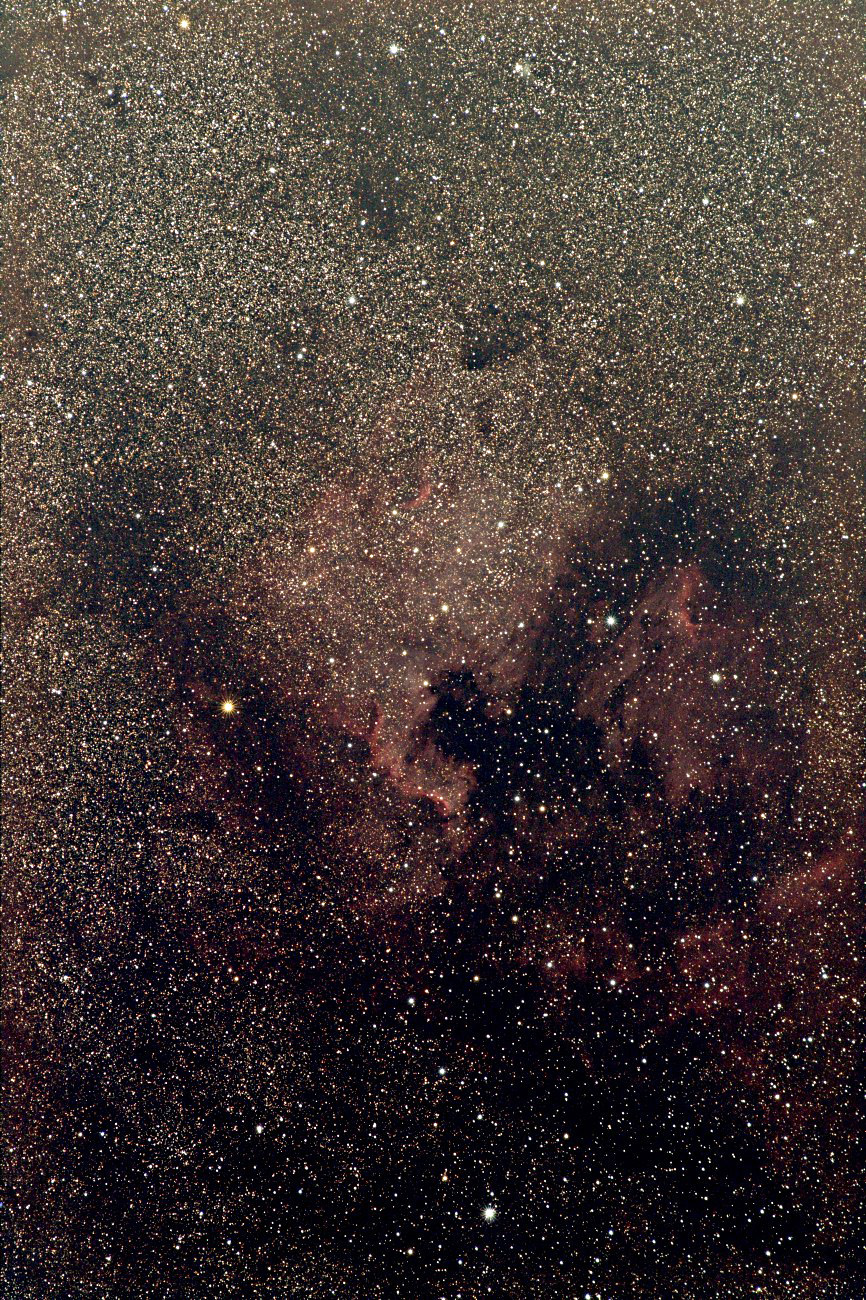
This should be quite comparable to the
picture that I took with a Nikon camera body
a couple of weeks ago,
but the Canon 60Da has extended red sensitivity to pick up more of the
faint red light emitted by hydrogen nebulae.
Click and see how you like each picture compared to the other.
Permanent link to this entry
NGC 7822 and Cederblad 214
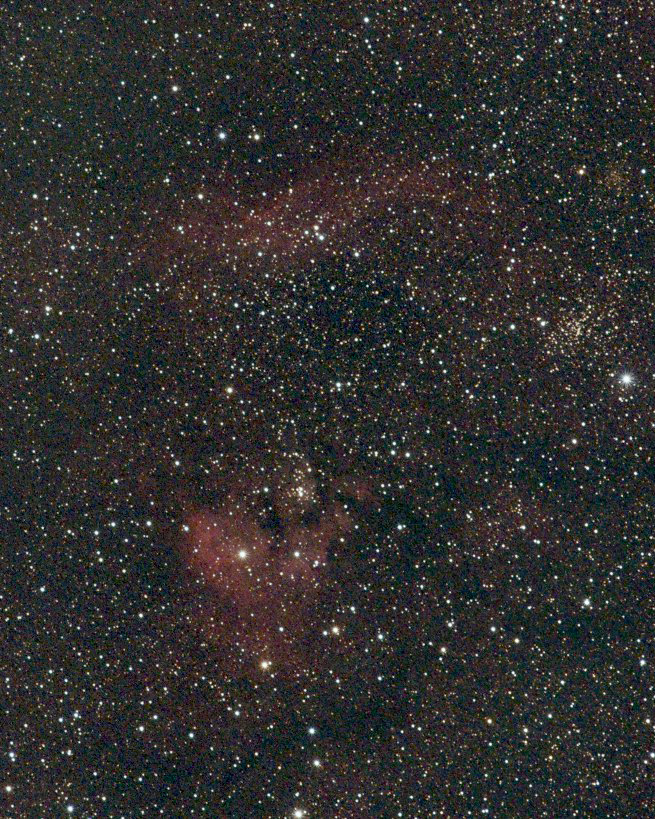
These faint nebulae are, respectively, NGC 7822 (top) and Cederblad 214 (bottom).
The star cluster at the right is NGC 7762. They are in the constellation Cepheus,
and I'm surprised I was able to photograph them from town.
Helix Nebula
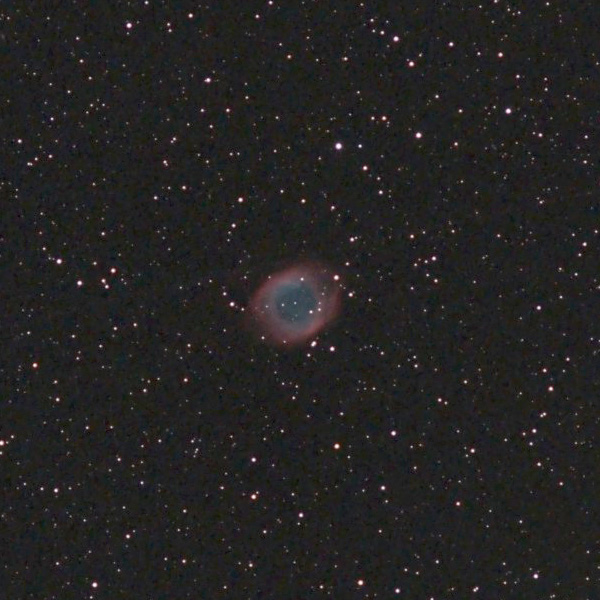
Here's the Helix Nebula (NGC 7293), a well-known (but very faint) nebula
in the constellation Aquarius,
the remains of a star that blew off its atmosphere.
It is not actually helical, but a few strands of thicker gas make it appear so.
Permanent link to this entry
M33
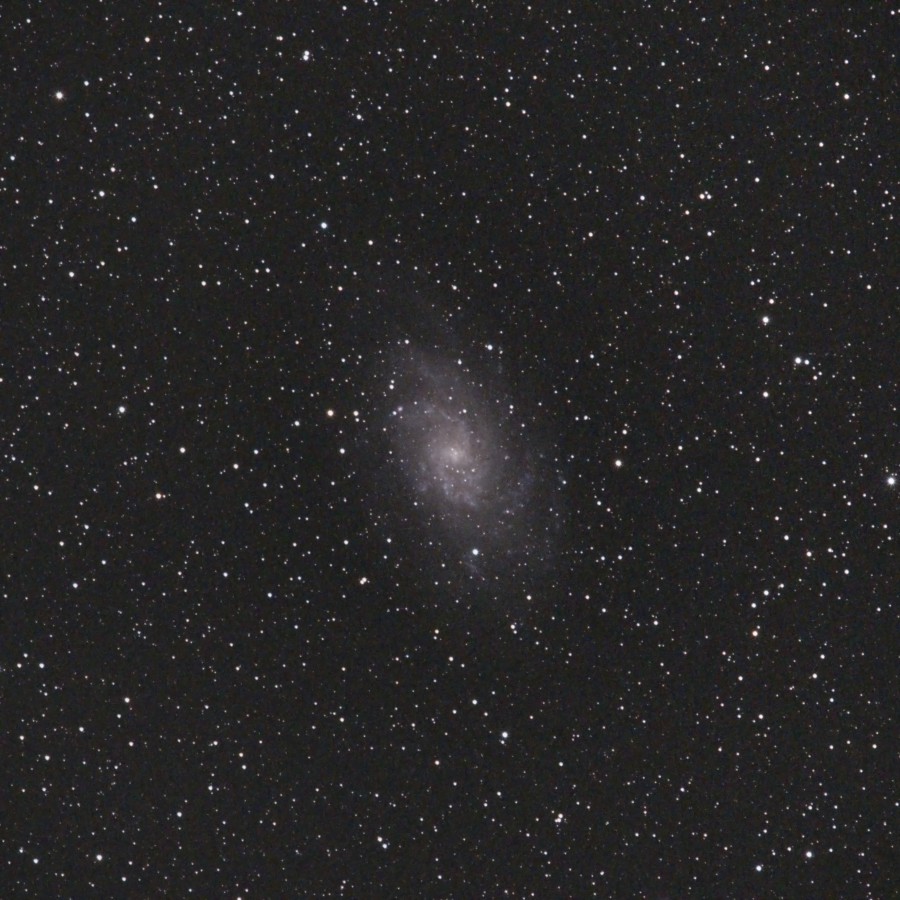
This is the galaxy M33 in Triangulum, which I have photographed often
as a test of various piece of equipment.
At its upper left is a pair of stars, one of which is fuzzy.
The fuzzy one is actually a great nebula in the distant galaxy;
the sharp one is a foreground star.
Permanent link to this entry
Double Cluster with dark nebulae
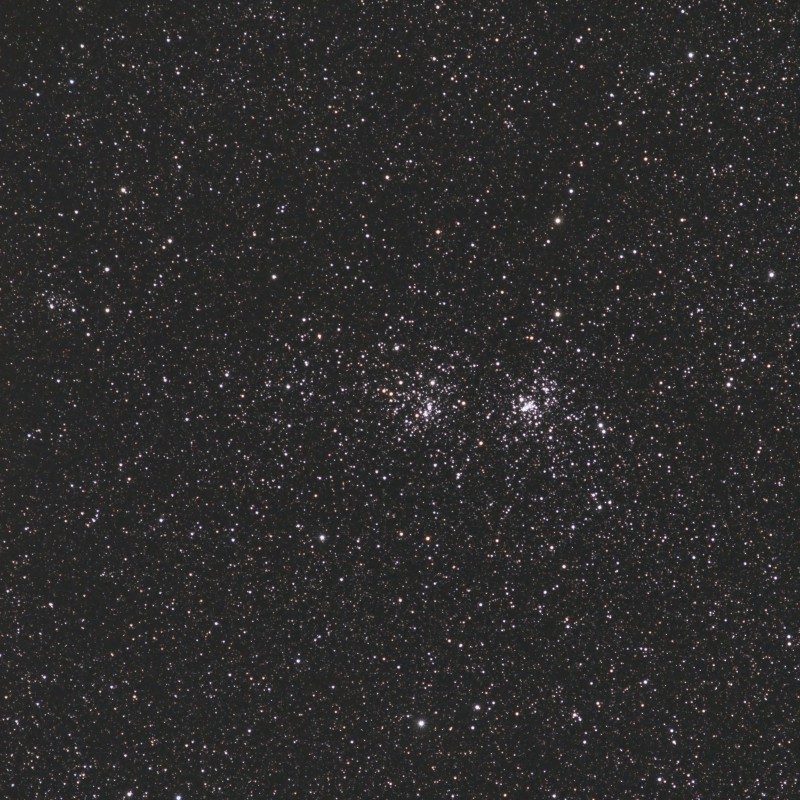
Finally, here is the Double Cluster (NGC 869 and 884) in Perseus.
I want to call your attention to the background, and in particular,
the subtle diagonal streaks above and to the right of the cluster where there
is a relative lack of stars. (One bright row of stars runs parallel to them.)
The dark streaks are dark nebulae, made of interstellar dust, and so is
the small starless patch to the right of the clusters, which is designated
Barnard 201.
Permanent link to this entry


|
2018
October
28
|
Pittsburgh
All civilized and decent people deplore and denounce the terrible shooting in Pittsburgh yesterday, which comes all too close to being a resumption of the worst horrors of the 20th Century.
All, not just the ones who added a Star of David to their Facebook picture or made a special statement on social media.
Some of us added a Star of David to our Facebook pictures
to show support for the victims and to denounce the crime.
Others did not because they thought it might strike some people as misappropriation of a sacred symbol;
or because they made their statement another way;
or because they felt that the wrongness of such a horrible crime went without saying.
At times like these, we must take care not to be divided over
well-meaning people's use of symbols.
I salute my friends who have changed their pictures,
and also those who express their opposition to genocide in other ways.
Permanent link to this entry


|
2018
October
24
|
How I matched wits with a computer and won Melody's heart
[Updated with corrections.]
I've blogged a lot of the story of
how
Melody and I met,
but I've omitted one thing I did,
on the day we met, that really impressed her.
The program for the day's activities included a tour of the
University of Georgia computer center.
The year was 1975, and most people had never seen a personal computer or
microcomputer; the Apple II was still in the future.
What we saw was a CDC CYBER 70/74
mainframe computer,
and it looked somewhat like this, though installed in a more crowded machine room:
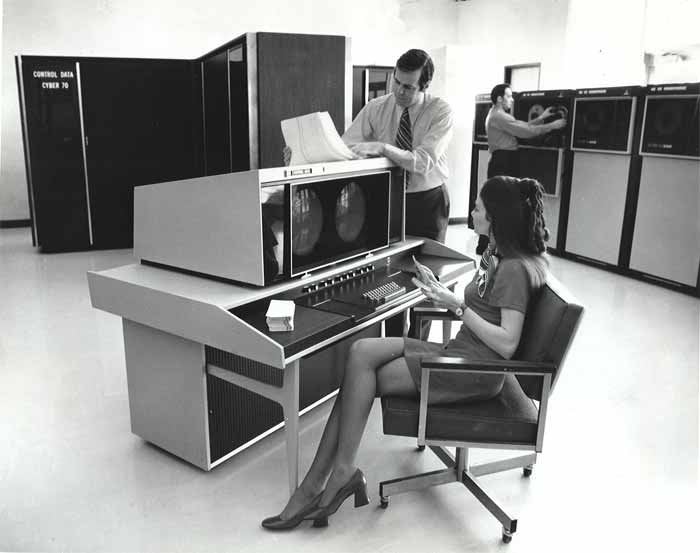
Control Data Corporation advertising photo
(Operators were allowed to dress less dramatically, and ours did.)
The CYBER was being demonstrated for us by systems programmer Ken Williams, whom I knew from my
part-time job working with the computers.
Probably not even realizing I would appreciate the
opportunity to impress a girl, Ken challenged me to a battle of wits.
He would call out a mathematical problem and the computer would solve it at the same time I did,
if I could, and we'd see who would get the answer first.
The problem was, "What is the sum of all the integers, inclusive, from 1 to 1 million?"
I remembered just enough of Gauss's way of summing the integers from 1 to 100, and the pattern of
digits, to start calling out, "5 0 0 0 0 0 5 0 0 0 0 0," one digit at a time, just as the
computer's answer started to appear on the console.
Fortunately it agreed with me. It had of course done the arithmetic the hard way.
And the CPU is at most 10 or 15 times faster than the
first IBM PC, so it took a couple of seconds to launch the program
and do a million additions. That was just
long enough for me to finish neck-and-neck with it and impress my future wife,
the extraordinary Melody Mauldin.
Permanent link to this entry


|
2018
October
21
|
Nathaniel's refractor rides again
My son-in-law, Nathaniel Barrett, found his boyhood telescope a while back
and gave it to me to fix up. I've finally finished the project. Here you see
it mounted on my Celestron AVX, which is a bit fancier than its original equatorial
mount, which is still up in Kentucky:
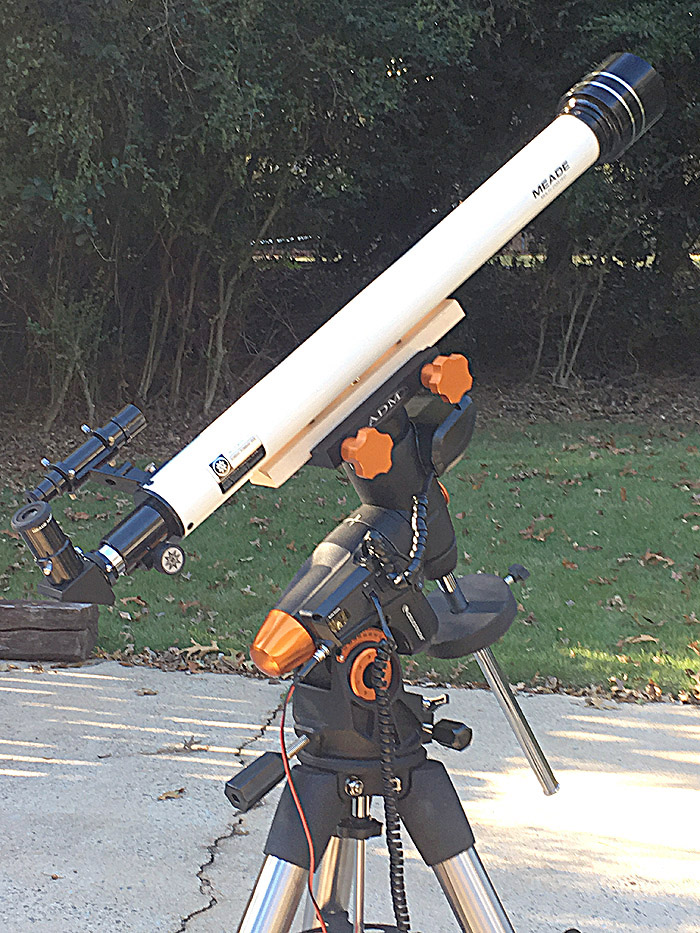
The fixing up consisted of giving it a good cleaning, a new 5×24 finderscope,
a 1.25-inch (American-size) focuser, and a new diagonal and eyepiece
(actually, at the moment, any of several eyepieces, because my entire collection fits it).
The views are quite good.
One red herring, during testing, is that a super-economy MA25mm eyepiece that I was
using for testing turned out to have spherical aberration of its own.
With it out of the way, the telescope itself is either diffraction-limited or close to it.
Because the glare stops are for Japanese-size eyepieces, it doesn't work well with some
of the widest-field eyepieces, but a vintage 30-mm Criterion "ASP" (asymmetric Plössl?)
gives a very sharp view.
I had a telescope like this when I was young, a Tasco 9TE, and always wanted to take a
picture through it but never had all the adapters and appropriate camera. Tonight I put my
Canon 60Da on Nathaniel's telescope and photographed the moon:
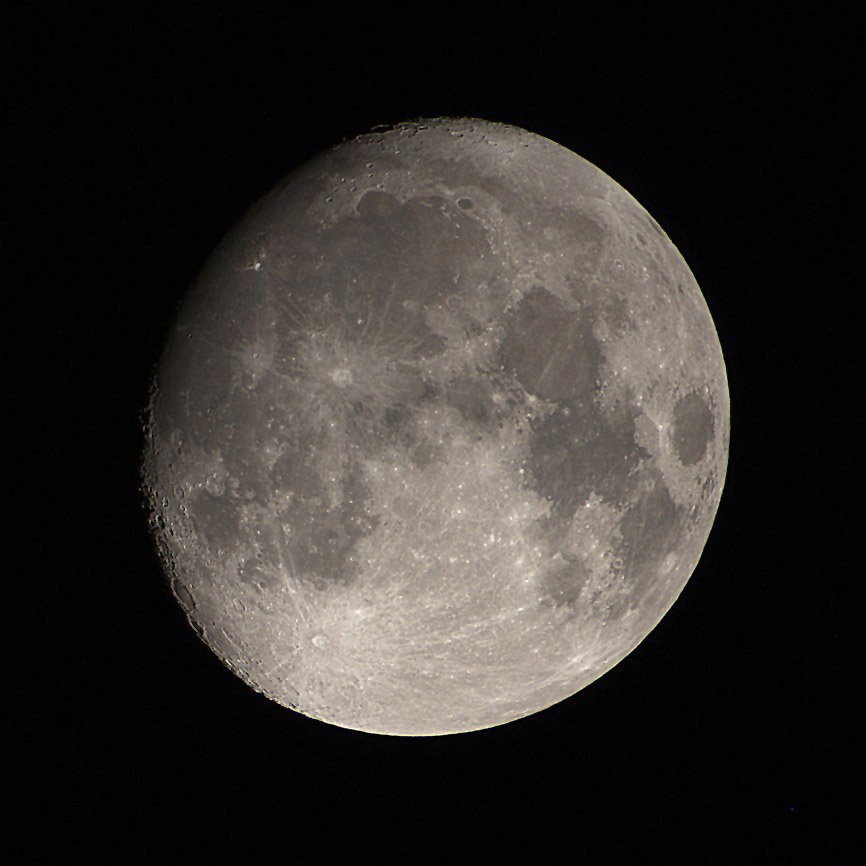
Not bad at all, if I may say so. One frame, digitally sharpened in the usual manner.
Permanent link to this entry


|
2018
October
17
|
Downfall and restoration of the drive-out lights
Those who read about the
astronomy drive-out lights
that I added to my car in 2015 may, perhaps, be sad to hear that they
were seriously damaged recently, I don't know exactly where or when.
Because they still lit up, we didn't notice the damage immediately, but
a close look showed that they had been bashed in and their lenses broken.
We assume someone backed into them with a trailer hitch, since they're at
just that height, and the plastic bumper cover must have flexed as much as three inches,
then returned to its original position.
At first we thought a car wash had broken the lenses and displaced the lights,
but no — their brackets were severely bent, the effect of hundreds of
pounds of force.
And those lights and brackets gave their all to protect the air
conditioning condenser, which was right behind them!
At first I thought about simply removing them, or improvising some kind of
new setup with an LED strip, but Melody wisely advised that I wouldn't be happy
until I fixed them as good as new.
And, fortunately, I had written down in my automotive logbook the make and
model of the lights, which are
still available on Amazon
though not locally.
So I ordered them, they came, and in two short sessions I completed the repair.
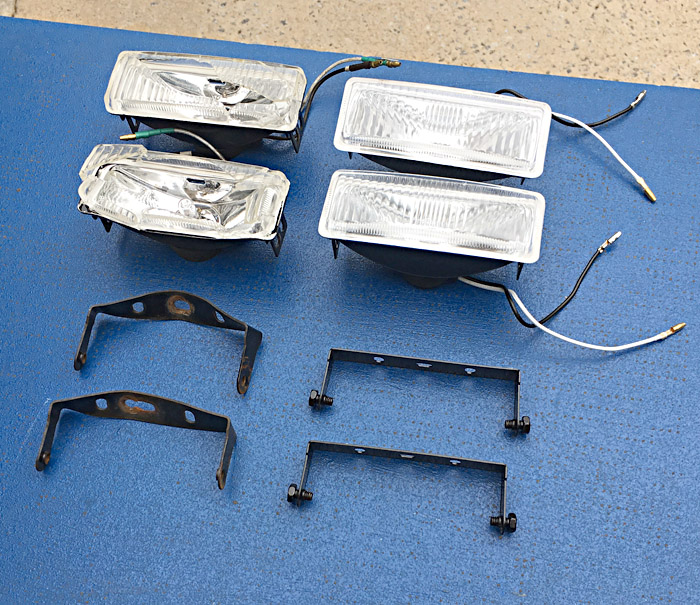
Here you see the old parts and the replacements. Look at how much those brackets were
bent!
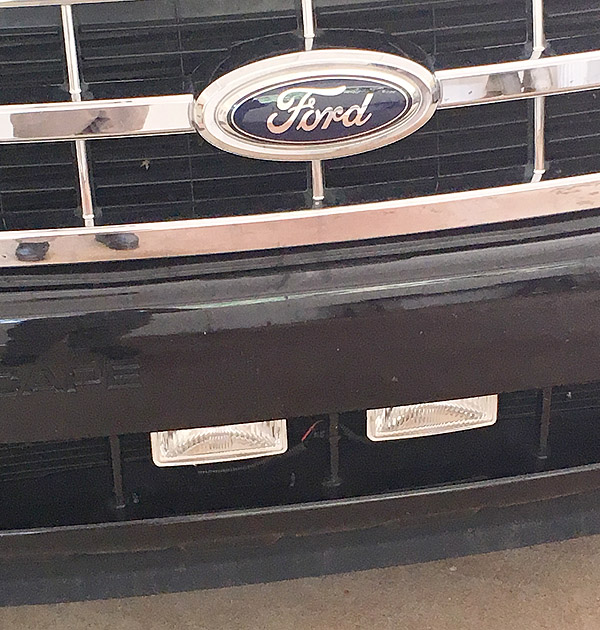
And there they are, good as new.
The only excitement during the repair session was when a tube of black silicone seal
burst in the middle. I will be getting the black stains off my hands for days.
Permanent link to this entry


|
2018
October
15
|
And North America too
Musicians have themes, and I have a celestial object I particularly
like to photograph — a nebula shaped like the continent I live on.
(Giving a talk in London, I once put a slide of this on the screen and
pointed to a spot on it: "That's where I live.")
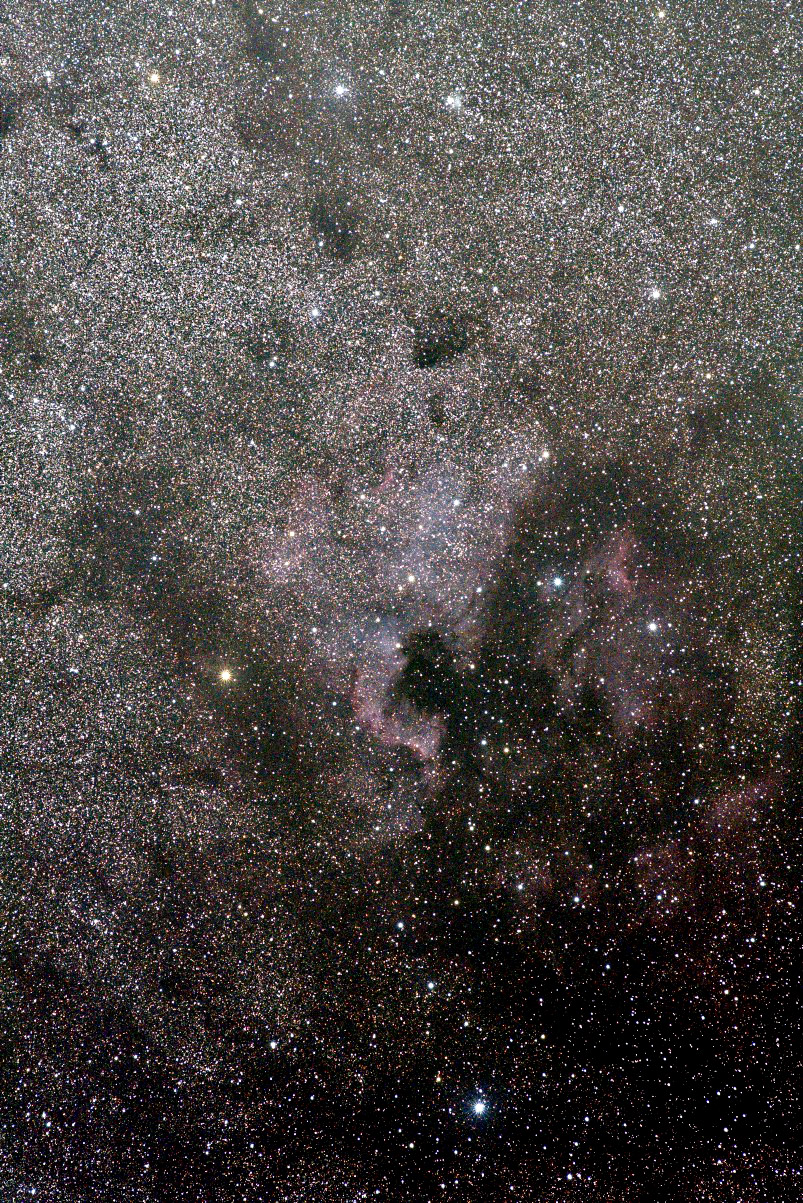
This is a stack of eight 93.5-second exposures taken with a Nikon D5300 at ISO 200
and a Nikon 180/2.8 ED AI lens at f/4, in my driveway in Athens, Georgia.
I didn't expect the nebula to show up because the air wasn't particularly clear
and this camera does not have extended red sensitivity (to pick up the hydrogen-alpha
wavelength at which this nebula shines brightest).
But I was pleasantly surprised.
On this picture I used some HDR processing to lighten the dark areas and darken the light
areas, on a large scale only, so that smaller details would show up.
In the original picture, the top, which is a thick star cloud in the Milky Way,
was a lot lighter than the bottom.
Permanent link to this entry


|
2018
October
14
|
And if I seem to be repeating myself...
Here's the Andromeda Galaxy again:
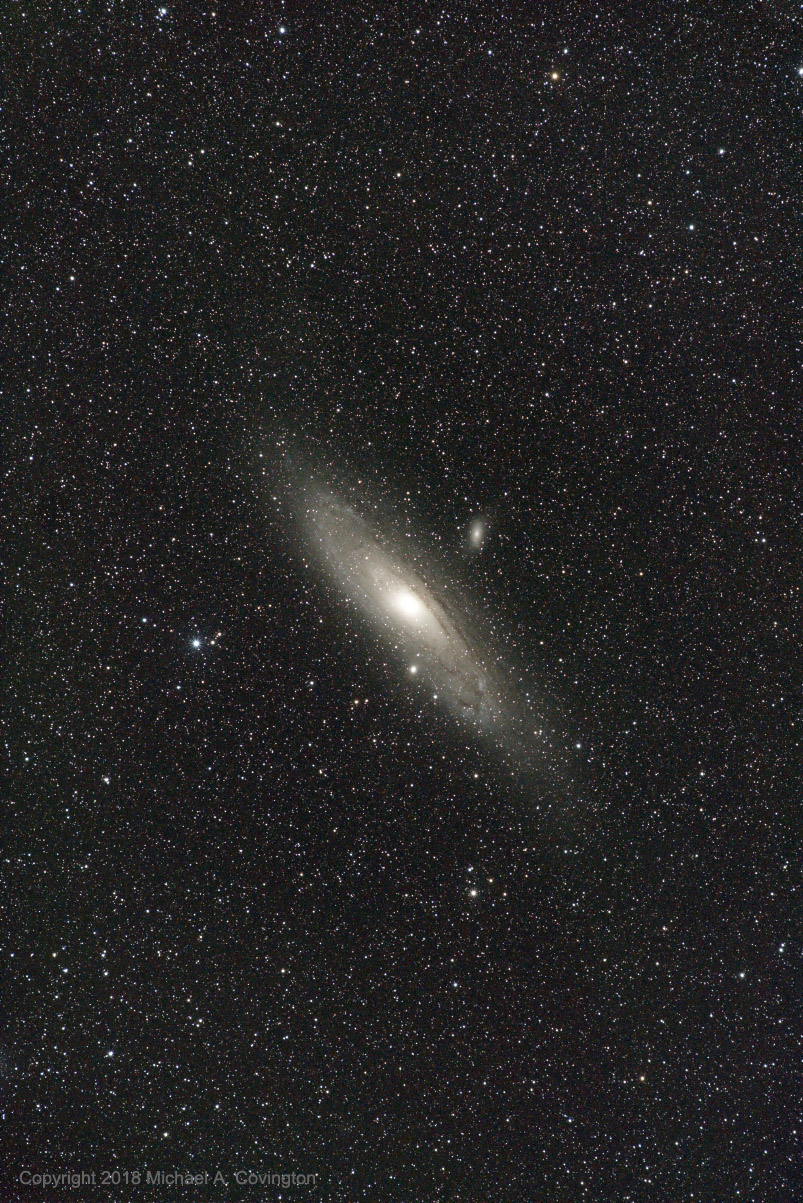
Different camera, different lens, slightly worse atmospheric conditions.
This is my Nikon D5300 at ISO 200, a stack of twenty 93.5-second exposures
(my timer has ideas of its own about round numbers!)
with my vintage Nikon 180-mm f/2.8 ED AI lens at f/4.
Again, look how sharp the stars are from corner to corner.
The secret to using this lens seem to be to set it to f/4; in those days
they didn't aim for optical perfection at the widest aperture, and this
one shows an assortment of aberrations at f/2.8.
By exposing about 90 seconds instead of 3 minutes, I get perfect tracking without
having to make guiding corrections. The 3-minute exposures yesterday were
pushing the limits a bit.
Permanent link to this entry


|
2018
October
13
|
A pleasant surprise from a little-known vintage lens
Olympus Zuiko 200-mm f/5 is very sharp for astrophotography
Take a look at this picture of the Andromeda Galaxy.
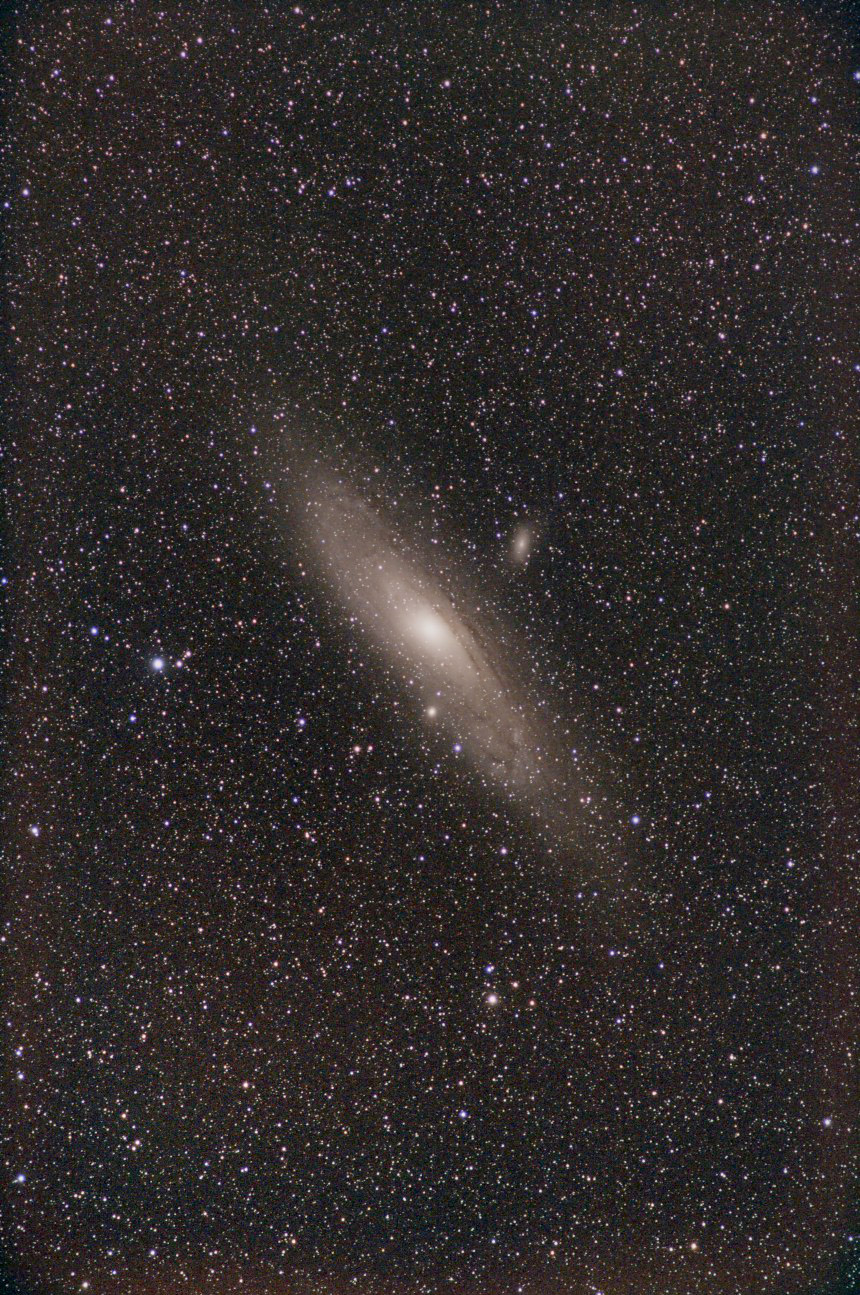
Copyright 2018 Michael A. Covington
Reprocessed to show more of the galaxy.
Click here to see the first version.
It's a stack of eleven 3-minute exposures with a Canon 60Da and a little-known vintage lens.
Notice that the stars are sharp from corner to corner.
Even high-end lenses don't always achieve that.
So the lens must be a good one.
It is in fact an Olympus Zuiko 200-mm f/5 telephoto lens,
made for the OM series of film SLRs in the 1970s (not the present-day OM-D),
and attached to my Canon 60Da with a Fotodiox adapter:
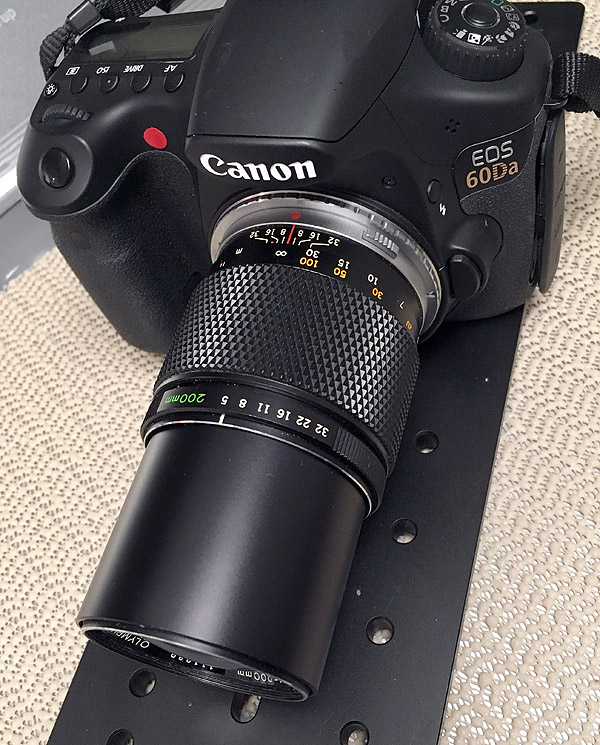
Right, f/5, not f/4. There is a much more common Zuiko 200-mm f/4 described
in the Olympus OM System Lens Handbook, which doesn't mention an f/5 version.
And we see from the front that this is an F Zuiko, which means it has six elements.
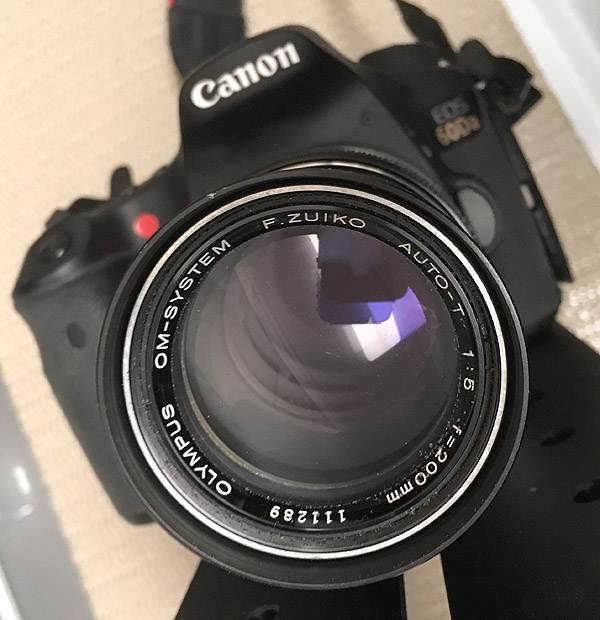
The only information I can find on line about this lens is
at Mir
in Malaysia, and even he doesn't have an optical diagram of it.
Note that the competing 200-mm f/4 lens has 5 elements; the f/5 has six!
So the smaller f-stop does not mean this is a lower-quality lens; on the
contrary, it is a premium optic.
But everyone thinks that f/5 is not as good as f/4, so used lenses of this
type are remarkably cheap — often $50 to $100. There are several
on eBay right now.
Mine is not "MC," not multi-coated, so it must be of fairly early vintage.
In fact, since it's designed to take the same 49-mm filters as several other
Olympus lenses, it probably dates from the very beginning of the OM system,
and I would guess that the f/4 lens replaced it later. I know the f/4 lens
exists in MC versions.
[Update:] What I gather from several sources is that this lens was discontinued
early on. The original idea was that several OM lenses would all take 49-mm filters
(50/1.8, 100/2.8, 135/3.5, 200/5). But people felt that 135/3.5 and especially 200/4
were too slow and wanted larger lens openings even if this meant larger filters.
Thus the 135/2.8 and 200/4 were introduced. The 200/5 was apparently
discontinued before the
Lens Handbook came out.
What I don't know is whether all units of this lens are this good or if I just
got lucky. Manufacturing tolerances take their toll, and I may have gotten hold
of a lens with unusually good centration of all the elements. (Decentering is
one of the most common faults in mass-produced lenses.)
What I know is that it's a remarkably lightweight lens, as well as being
remarkably sharp. I'll continue to use it.
Permanent link to this entry


|
2018
October
12
|
Planets
You'll be relieved to know that we got only rain from the hurricane;
Athens is in a narrow wedge of Georgia that never had high winds.
Just before the hurricane came, our old friend Doug Downing spent several
days here, and we did some astrophotography together.
On the evenings of the 3rd and 4th (4th and 5th Greenwich Mean Time),
the air was unusually steady, and we got reasonable pictures of Mars and Saturn
even though they were both rather low in the sky, and Mars is considerably
farther away than just a few weeks ago. First, Mars:
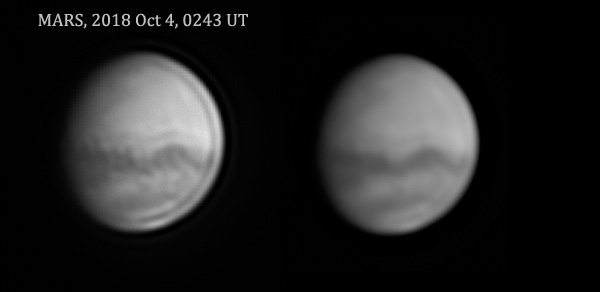
Stack of video frames taken in near infrared light with my C8 EdgeHD, 3x extender,
and ASI120MM-S camera. The same picture is shown with different amounts of digital
sharpening. The first picture is strongly sharpened and shows lots of detail but also
a strong "rind" on the right-hand side; the second picture is less strongly sharpened.
The "rind" is thought to be a diffraction effect in the telescope; it is visible to
a slight extent even on images that have not been digitally sharpened at all.
Next, Saturn, in infrared and then in color; same equipment as above, but the color
image is with a clear filter and ASI120MC-S camera.
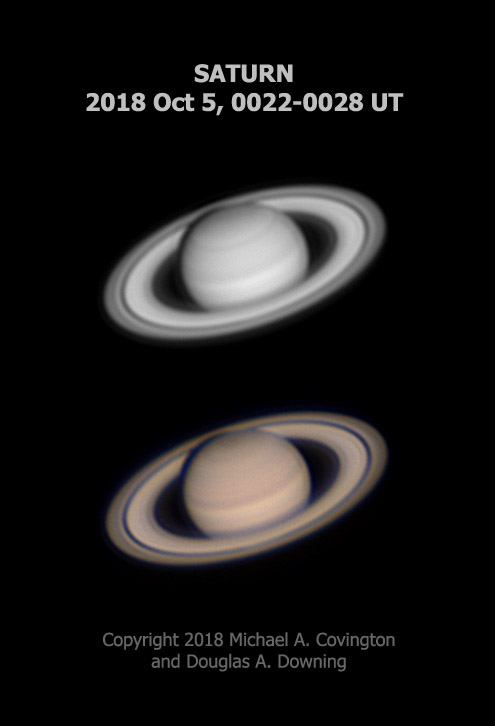
Permanent link to this entry
Deeper into space
Using his Canon XSi (400D) camera with my equipment, Doug took some pictures of
more distant objects too. These are notable because the periphery of Athens does
not have especially dark skies at the best of times, and the air was noticeably
hazy when these pictures were taken. But here is the elusive Helix Nebula (NGC 7293),
photographed in town, a stack of thirty 30-second exposures with a Sigma 105-mm f/2.8
lens:
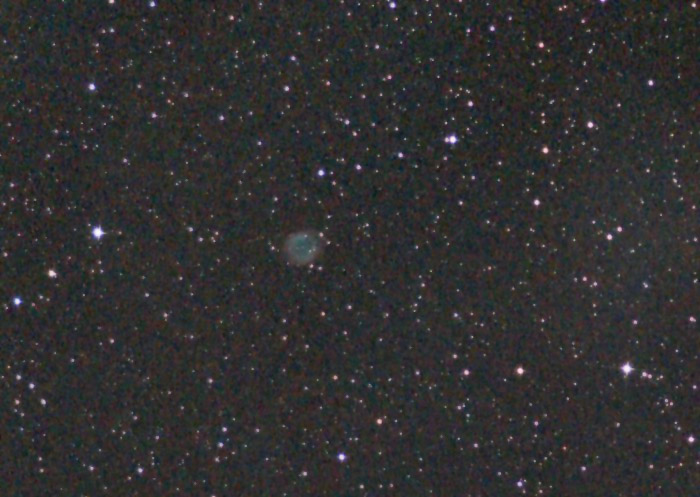
Copyright 2018 Douglas A. Downing
And here is the Dumbbell Nebula (M27), a stack of twenty 30-second exposures with my
AT65EDQ refractor (6.5 cm aperture, f/6.5):
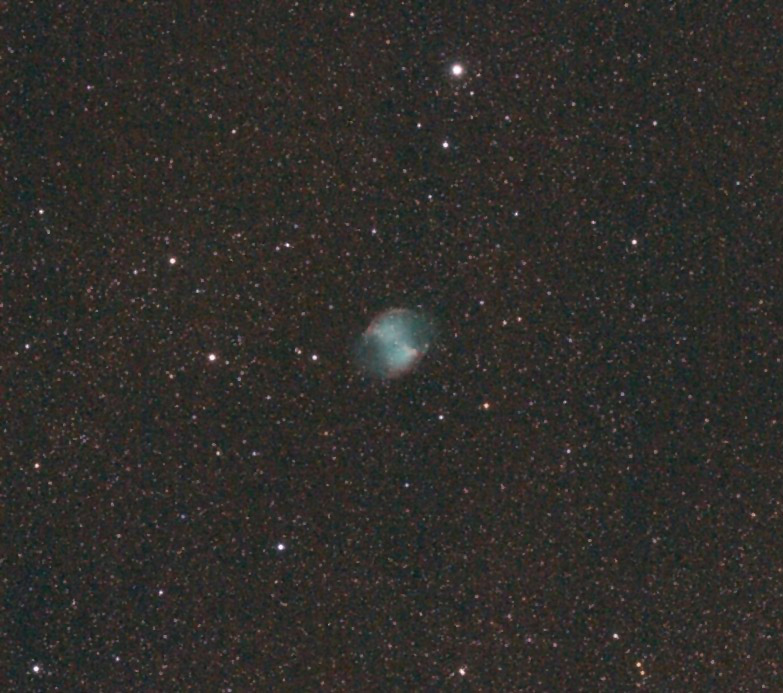
Copyright 2018 Douglas A. Downing
Permanent link to this entry


|
2018
October
10
|
Stormy
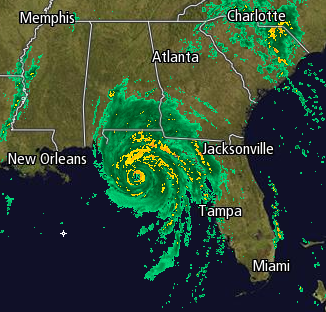
I think it's going to be rainy tomorrow.
That's Hurricane Michael (not named after me!), coming ashore in Florida
and moving northeast.
I'm located right at the "a" at the end of the word "Atlanta" on that map.
Permanent link to this entry


|
2018
October
9
|
Mende Miller, 1957?-2018
I have learned, without details, that my kindergarten classmate Mende Miller
is no longer with us.
She was the roller-skating diva of
Mrs.
Morgan's 1962-63 kindergarten class (Moultrie, Georgia);
while the rest of us either struggled through skating lessons or
(in my case) sat them out, she made graceful arcs and circles all over the
skating rink (and I watched).
I haven't seen Mende since kindergarten or shortly afterward but had heard from her in recent
years on Facebook. I know little about her adult life.
My understanding is that she graduated from Moultrie High School in 1975 and
that at the time of her death, she had recently moved to Kansas City, Missouri.
May her memory be eternal.
Permanent link to this entry


|
2018
October
7
|
Crowd madness: people on Facebook are telling each other falsely that
they have received suspicious friend requests
[Updated.]
If you receive a Facebook message like this, it's a hoax:
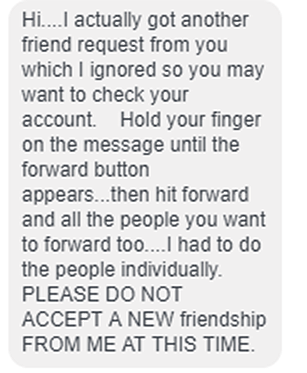
You haven't been hacked or impersonated.
Somebody just sent you a copy of a message that is being copied and forwarded like wildfire.
Contact the person who sent you the message and ask, "Did you really get a
suspicious friend request from me? And did you type that message yourself?
And if you didn't get a friend request from me, why did you tell me you did?"
Normally the answer is no — they didn't get a friend request —
they just forwarded the message because it
said to forward it, even though it is not true.
That's why it is letter-for-letter identical, including a spelling error, everywhere
it turns up!
Some people can't resist following instructions from a total stranger.
(Next time, instead of just a message, maybe send me all your money?
Would you do that if a total stranger said to?)
The people who forwarded this should be embarrassed.
They have made pests of themselves. I have friends who have gotten 20 or 30 copies of the message.
Click here for more details (from Lifehacker).
Contrary to my earlier suspicions, there is no sign of any malware,
virus, or hacking being involved.
It is just people telling each other to forward a message.
Now if someone did get a friend request apparently from you,
even though they're already on your friends list,
click here
to learn how to detect impersonation and what to do about it.
And check your Facebook security settings.
If you think someone might have gotten into your account, change your password
and set Facebook to e-mail you whenever people log into your account.
Permanent link to this entry


|
2018
October
1-5
|
Ahoy-hoy!
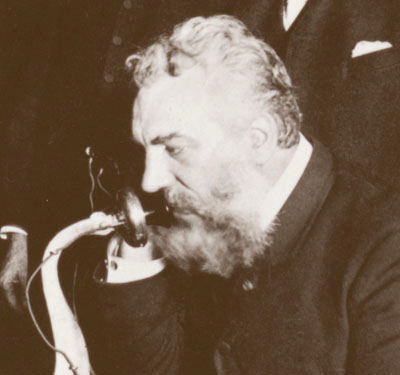
"Ahoy-hoy!" is how Alexander Graham Bell wanted people to answer the telephone.
(Only Mr. Burns, on The Simpsons, actually does.)
Edison advocated "Hello," which caught on.
Both wanted to stem what they considered the rude practice of answering the
phone with "Who is this?" or calling someone and responding to their answer
with "Who is this?"
Better yet, said the experts, was to answer the telephone by identifying
yourself — which is what I do.
"This is Michael Covington, may I help you?"
Robocalling machines think I'm speaking gibberish and don't play their recordings.
As you read this, my home telephone number (ending in 3), the number I've had
since 1973, has been ported over to a Spectrum VOIP line, and POTS (land line service)
to my house has been discontinued. The VOIP modem fakes a POTS exchange so well
that all we had to do was connect it to the house telephone wiring, and we get a dial tone
and can dial in the usual manner (with tone dialing; I don't know if pulse dialing
is supported). The sound quality is, if anything, better than before.
And I can guess that AT&T was already doing much the same thing.
I suspect the wires to my house didn't go all the way to a bank of 48-volt batteries
and other hardware downtown, but rather to a VOIP modem just down the street or
up on a pole somewhere.
What was disappointing is that the porting took 4 days. It was scheduled for
October 2, so on the evening of the 1st, I went under the house and changed
the wiring. On October 3 the porting didn't happen; the old number still went
to the AT&T wires, now disconnected, and anyone who dialed it would hear a
ringing signal that was never answered. Meanwhile, the VOIP line worked, but
with a temporary number. On October 3 the AT&T line went dead; anyone
dialing our old number got warning tones and "This number is not in service."
So it remained until I called Spectrum today (October 5), and they performed
the changeover as I talked to them. Naturally, I was talking to them on the VOIP line
and got cut off, but then they called me at the new number.
There is a good side to this. For more than two days, all those robocallers were
getting "This number is no longer in service," with warning tones that their
equipment could easily recognize, and today they haven't been calling us!
Happy birthday, Melody!
For her birthday Melody was taken to dinner by two Yale Ph.D.'s.
That's what it takes to keep up with her formidable intellect.
Permanent link to this entry


|
|
|
This is a private web page,
not hosted or sponsored by the University of Georgia.
Copyright 2018 Michael A. Covington.
Caching by search engines is permitted.
To go to the latest entry every day, bookmark
http://www.covingtoninnovations.com/michael/blog/Default.asp
and if you get the previous month, tell your browser to refresh.
Portrait at top of page by Sharon Covington.
This web site has never collected personal information
and is not affected by GDPR.
Some older pages that contain Google Ads may use cookies to manage the rotation of ads.
No personal information is collected or stored by Covington Innovations, and never has been.
This web site is based and served entirely in the United States.
In compliance with U.S. FTC guidelines,
I am glad to point out that unless explicitly
indicated, I do not receive substantial payments, free merchandise, or other remuneration
for reviewing or mentioning products on this web site.
Any remuneration valued at more than about $10 will always be mentioned here,
and in any case my writing about products and dealers is always truthful.
Reviewed
products are usually things I purchased for my own use, or occasionally items
lent to me briefly by manufacturers and described as such.
I am an Amazon Associate, and almost all of my links to Amazon.com pay me a commission
if you make a purchase. This of course does not determine which items I recommend, since
I can get a commission on anything they sell.
|
|


























